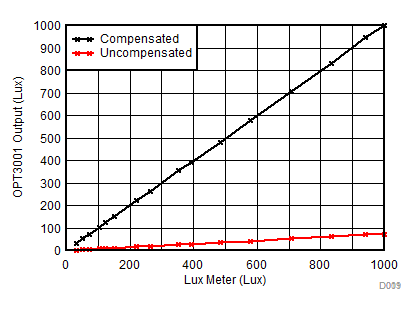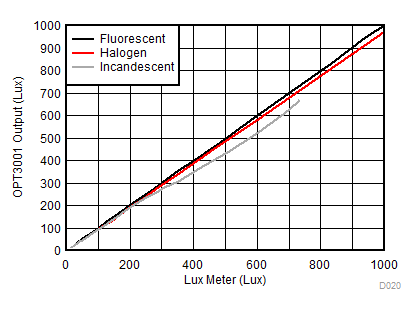JAJSD52A March 2017 – December 2018 OPT3001-Q1
PRODUCTION DATA.
- 1 特長
- 2 アプリケーション
- 3 概要
- 4 改訂履歴
- 5 概要(続き)
- 6 Pin Configuration and Functions
- 7 Specifications
-
8 Detailed Description
- 8.1 Overview
- 8.2 Functional Block Diagram
- 8.3 Feature Description
- 8.4 Device Functional Modes
- 8.5 Programming
- 8.6
Register Maps
- 8.6.1
Internal Registers
- 8.6.1.1
Register Descriptions
- 8.6.1.1.1 Result Register (offset = 00h)
- 8.6.1.1.2 Configuration Register (offset = 01h) [reset = C810h]
- 8.6.1.1.3 Low-Limit Register (offset = 02h) [reset = C0000h]
- 8.6.1.1.4 High-Limit Register (offset = 03h) [reset = BFFFh]
- 8.6.1.1.5 Manufacturer ID Register (offset = 7Eh) [reset = 5449h]
- 8.6.1.1.6 Device ID Register (offset = 7Fh) [reset = 3001h]
- 8.6.1.1
Register Descriptions
- 8.6.1
Internal Registers
- 9 Application and Implementation
- 10Power Supply Recommendations
- 11Layout
- 12デバイスおよびドキュメントのサポート
- 13メカニカル、パッケージ、および注文情報
9.2.3 Application Curves
To validate that the design example now measures correctly, create a sequential number of different light intensities with the fluorescent light by using neutral density filters to attenuate the light. Different light intensities can also be created by changing the distance between the light source, and the measurement devices. However, these two methods for changing the light level have minor accuracy tradeoffs that are beyond the scope of this discussion. Measure each intensity with both the lux meter and the OPT3001-Q1 device under the window, and compensate using Equation 5. The results are displayed in Figure 37, and show that the application accurately reports results very similar to the lux meter.
To validate that the design measures a variety of light sources correctly, despite the large ratio of infrared transmission to visible light transmission of the window, measure the application with a halogen bulb and an incandescent bulb. Use the physical location and light attenuation procedures that were used for the fluorescent light. The results are shown in Figure 38.
The addition of the dark window changes the results as seen by comparing the results of the same measurement with a window (Figure 38) and without a window (Figure 3). Even after the expected change, the performance is still good. All data are both within 15% of the correct answer, and within 15% of the other bulb measurements.
Results can vary at different angles of light because the OPT3001-Q1 device does not match the lux meter at all angles of light.
If the measurement variation between the light sources is not acceptable, choose a different window that has a closer ratio of visible light transmission to infrared light transmission.
 Figure 37. Uncompensated and Compensated Output of the OPT3001-Q1 Grade 3 Device Under a Dark Window Illuminated by Fluorescent Light Source
Figure 37. Uncompensated and Compensated Output of the OPT3001-Q1 Grade 3 Device Under a Dark Window Illuminated by Fluorescent Light Source  Figure 38. Compensated Output of the OPT3001-Q1 Grade 3 Device Under a Dark Window Illuminated by Fluorescent, Halogen, and Incandescent Light Sources
Figure 38. Compensated Output of the OPT3001-Q1 Grade 3 Device Under a Dark Window Illuminated by Fluorescent, Halogen, and Incandescent Light Sources